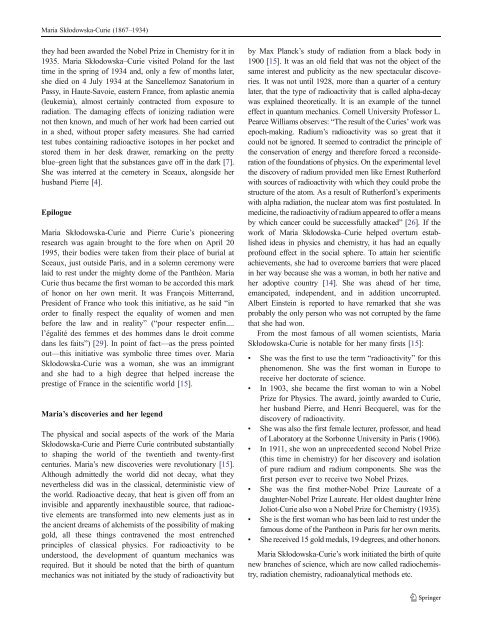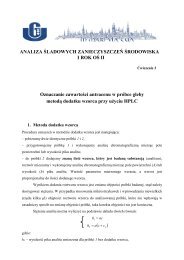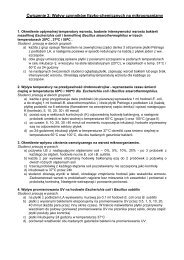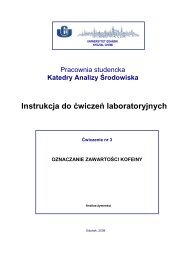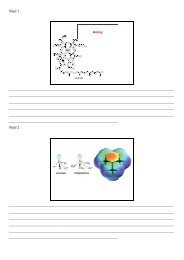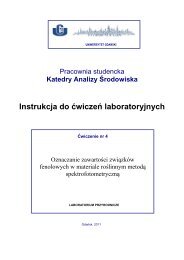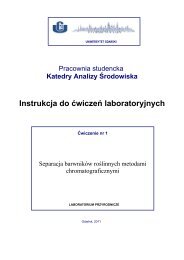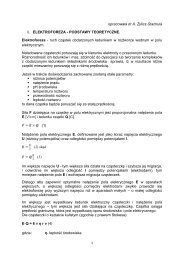Maria Skłodowska-Curie (1867–1934)—her life and discoveries
Maria Skłodowska-Curie (1867–1934)—her life and discoveries
Maria Skłodowska-Curie (1867–1934)—her life and discoveries
You also want an ePaper? Increase the reach of your titles
YUMPU automatically turns print PDFs into web optimized ePapers that Google loves.
<strong>Maria</strong> <strong>Skłodowska</strong>-<strong>Curie</strong> (<strong>1867–1934</strong>)they had been awarded the Nobel Prize in Chemistry for it in1935. <strong>Maria</strong> <strong>Skłodowska</strong>–<strong>Curie</strong> visited Pol<strong>and</strong> for the lasttime in the spring of 1934 <strong>and</strong>, only a few of months later,she died on 4 July 1934 at the Sancellemoz Sanatorium inPassy, in Haute-Savoie, eastern France, from aplastic anemia(leukemia), almost certainly contracted from exposure toradiation. The damaging effects of ionizing radiation werenot then known, <strong>and</strong> much of her work had been carried outin a shed, without proper safety measures. She had carriedtest tubes containing radioactive isotopes in her pocket <strong>and</strong>stored them in her desk drawer, remarking on the prettyblue–green light that the substances gave off in the dark [7].She was interred at the cemetery in Sceaux, alongside herhusb<strong>and</strong> Pierre [4].Epilogue<strong>Maria</strong> <strong>Skłodowska</strong>-<strong>Curie</strong> <strong>and</strong> Pierre <strong>Curie</strong>’s pioneeringresearch was again brought to the fore when on April 201995, their bodies were taken from their place of burial atSceaux, just outside Paris, <strong>and</strong> in a solemn ceremony werelaid to rest under the mighty dome of the Panthéon. <strong>Maria</strong><strong>Curie</strong> thus became the first woman to be accorded this markof honor on her own merit. It was François Mitterr<strong>and</strong>,President of France who took this initiative, as he said “inorder to finally respect the equality of women <strong>and</strong> menbefore the law <strong>and</strong> in reality” (“pour respecter enfin....l’égalité des femmes et des hommes dans le droit commedans les faits”) [29]. In point of fact—as the press pointedout—this initiative was symbolic three times over. <strong>Maria</strong><strong>Skłodowska</strong>-<strong>Curie</strong> was a woman, she was an immigrant<strong>and</strong> she had to a high degree that helped increase theprestige of France in the scientific world [15].<strong>Maria</strong>’s <strong>discoveries</strong> <strong>and</strong> her legendThe physical <strong>and</strong> social aspects of the work of the <strong>Maria</strong><strong>Skłodowska</strong>-<strong>Curie</strong> <strong>and</strong> Pierre <strong>Curie</strong> contributed substantiallyto shaping the world of the twentieth <strong>and</strong> twenty-firstcenturies. <strong>Maria</strong>’s new <strong>discoveries</strong> were revolutionary [15].Although admittedly the world did not decay, what theynevertheless did was in the classical, deterministic view ofthe world. Radioactive decay, that heat is given off from aninvisible <strong>and</strong> apparently inexhaustible source, that radioactiveelements are transformed into new elements just as inthe ancient dreams of alchemists of the possibility of makinggold, all these things contravened the most entrenchedprinciples of classical physics. For radioactivity to beunderstood, the development of quantum mechanics wasrequired. But it should be noted that the birth of quantummechanics was not initiated by the study of radioactivity butby Max Planck’s study of radiation from a black body in1900 [15]. It was an old field that was not the object of thesame interest <strong>and</strong> publicity as the new spectacular <strong>discoveries</strong>.It was not until 1928, more than a quarter of a centurylater, that the type of radioactivity that is called alpha-decaywas explained theoretically. It is an example of the tunneleffect in quantum mechanics. Cornell University Professor L.Pearce Williams observes: “The result of the <strong>Curie</strong>s’ work wasepoch-making. Radium’s radioactivity was so great that itcould not be ignored. It seemed to contradict the principle ofthe conservation of energy <strong>and</strong> therefore forced a reconsiderationof the foundations of physics. On the experimental levelthe discovery of radium provided men like Ernest Rutherfordwith sources of radioactivity with which they could probe thestructure of the atom. As a result of Rutherford’s experimentswith alpha radiation, the nuclear atom was first postulated. Inmedicine, the radioactivity of radium appeared to offer a meansby which cancer could be successfully attacked” [26]. If thework of <strong>Maria</strong> <strong>Skłodowska</strong>–<strong>Curie</strong> helped overturn establishedideas in physics <strong>and</strong> chemistry, it has had an equallyprofound effect in the social sphere. To attain her scientificachievements, she had to overcome barriers that were placedin her way because she was a woman, in both her native <strong>and</strong>her adoptive country [14]. She was ahead of her time,emancipated, independent, <strong>and</strong> in addition uncorrupted.Albert Einstein is reported to have remarked that she wasprobably the only person who was not corrupted by the famethat she had won.From the most famous of all women scientists, <strong>Maria</strong><strong>Skłodowska</strong>-<strong>Curie</strong> is notable for her many firsts [15]:&&&&&&&She was the first to use the term “radioactivity” for thisphenomenon. She was the first woman in Europe toreceive her doctorate of science.In 1903, she became the first woman to win a NobelPrize for Physics. The award, jointly awarded to <strong>Curie</strong>,her husb<strong>and</strong> Pierre, <strong>and</strong> Henri Becquerel, was for thediscovery of radioactivity.She was also the first female lecturer, professor, <strong>and</strong> headof Laboratory at the Sorbonne University in Paris (1906).In 1911, she won an unprecedented second Nobel Prize(this time in chemistry) for her discovery <strong>and</strong> isolationof pure radium <strong>and</strong> radium components. She was thefirst person ever to receive two Nobel Prizes.She was the first mother-Nobel Prize Laureate of adaughter-Nobel Prize Laureate. Her oldest daughter IrèneJoliot-<strong>Curie</strong> also won a Nobel Prize for Chemistry (1935).She is the first woman who has been laid to rest under thefamous dome of the Pantheon in Paris for her own merits.She received 15 gold medals, 19 degrees, <strong>and</strong> other honors.<strong>Maria</strong> <strong>Skłodowska</strong>-<strong>Curie</strong>’s work initiated the birth of quitenew branches of science, which are now called radiochemistry,radiation chemistry, radioanalytical methods etc.


